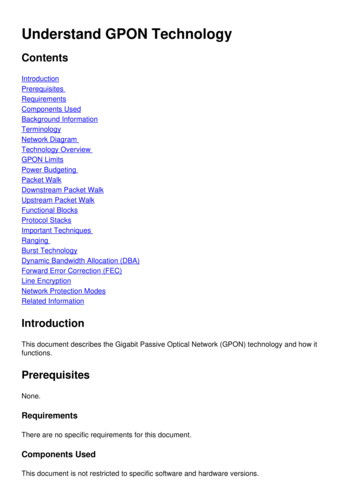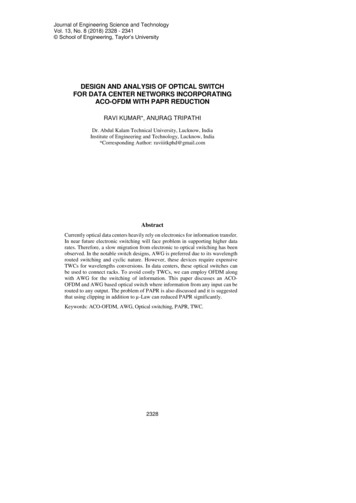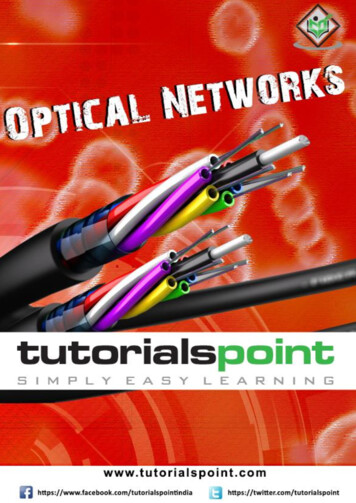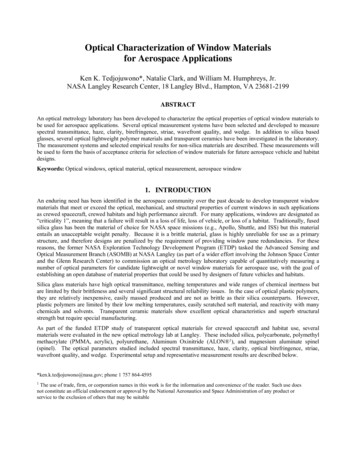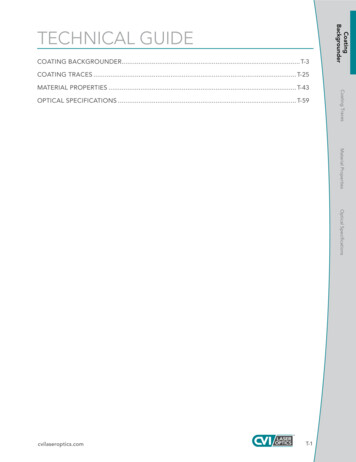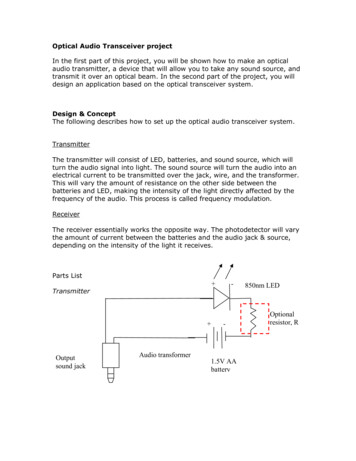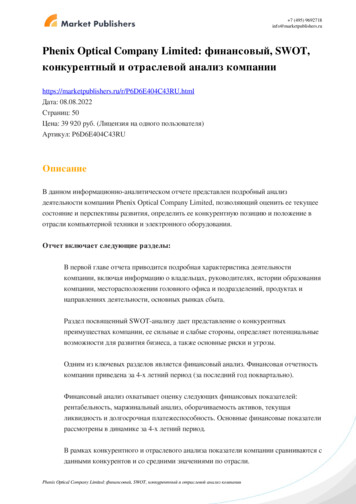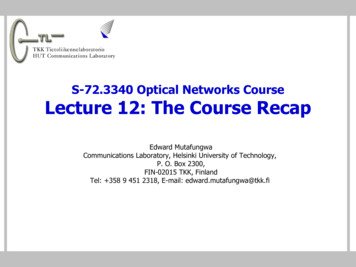
Transcription
S-72.3340 Optical Networks CourseLecture 12: The Course RecapEdward MutafungwaCommunications Laboratory, Helsinki University of Technology,P. O. Box 2300,FIN-02015 TKK, FinlandTel: 358 9 451 2318, E-mail: edward.mutafungwa@tkk.fi
1. Introduction Electrical communicationsDataSource.011010. Electricalsignal source Light or optical communicationsDataSourceElectrical signalElectrical signal.011010. Electricalsignal sourceLightsourceOptical signalApr 26, 2007EMu/S-72.3340/TheRecapSlide 2 of 54
1. IntroductionElectricalrepeaterMetallic cable Copper LinksOrbiting satellite Terrestrialradio links Satellite linksRadio relaystationsFiber Fiber linksApr 26, 2007Optical toelectricalconverterElectricalrepeaterO EElectrical toOpticalconverterE OEMu/S-72.3340/TheRecapSlide 3 of 54
1. Introduction Advantages of the fiber transmission media Low transmission loss (typically 0.2-0.5 dB/km) Large information carrying capacity (multi Gbit/s) Immunity to electromagnetic interference More secure to eavesdropping or wiretapping Smaller size and weightApr 26, 2007EMu/S-72.3340/TheRecapSlide 4 of 54
1. Introduction Link performance is limited r 26, 2007EMu/S-72.3340/TheRecapSlide 5 of 54
1. IntroductionBit Rate Graphical representation of fiber limitationsDispersionDispersion &Loss Apr 26, 2007EMu/S-72.3340/TheRecapSlide 6 of 54
2. Wavelength-Division MultiplexingFiberOptical toelectricalconverterElectricalrepeaterO EElectrical toOpticalconverterE OO EO EE OE OO EE OSpace-division multiplexing fiber link with electrical regenerationO EE OO EO EO EE OE OE OWDM fiber link with electrical regenerationOpticalamplifierWDM fiber link with optical amplificationApr 26, 2007EMu/S-72.3340/TheRecapSlide 7 of 54
2. Wavelength-Division MultiplexingAttenuation (dB/km) Amplified optical communications systems Optical amplification enables WDM in 1550 nm window Less attenuation than 850 nm and 1300 nm windows10First window“850-nm”Second window“1300-nm”Third window“1550-nm”5.02.01.00.5Standardfiber0.2Low water-peakFiber0.16008001000Optical signal sourcesavailableApr 26, 20071200140016001800Less loss and zeroλdispersionOptical amplification,even lower lossEMu/S-72.3340/TheRecap(nm)Slide 8 of 54
2. Wavelength-Division Multiplexing Coarse WDM (CWDM) ITU-T G.694.2/695 grid with 2500 GHz or 20 nm channel spacing 18 channels spanning O-, E-, S-, C- and L-bands (1260-1625 nm)Source: F. Audet, “Understanding CWDM,”EXFO application note.Apr 26, 2007EMu/S-72.3340/TheRecapSlide 9 of 54
2. Wavelength-Division Multiplexing DWDM enables many channels with amplification, .but requires stable transmitters and good filtering (sharp skirtsand precise center frequency) CWDM simplifies filter and transmitter design (cheaper) .but no amplification and few channelsSource: F. Audet, “Understanding CWDM,”EXFO application note.Apr 26, 2007EMu/S-72.3340/TheRecapSlide 10 of 54
2. Wavelength-Division Multiplexing A typical amplified WDM link includes: Optical transmitters and receivers (1 each per wavelength) Wavelength multiplexer and demultiplexers Optical amplifiers Boost amplifier: to increase the output power Line amplifier: to compensate for fiber losses Preamplifier: to improve receiver sensitivityApr 26, 2007EMu/S-72.3340/TheRecapSlide 11 of 54
2. Modulation/Demodulation Two popular optical modulation schemes On-off keying (OOK) modulation Subcarrier modulation (SCM)Apr 26, 2007EMu/S-72.3340/TheRecapSlide 12 of 54
2.1 On-Off Keying (OOK) Modulation It is possible to directly or externally modulate (i.e.turn off and on) a light source (laser or LED) Direct modulation simple, chirp External modulation more complex, less chirpApr 26, 2007EMu/S-72.3340/TheRecapSlide 13 of 54
2.1 On-Off Keying (OOK) Modulation Non-Return-to-Zero (NRZ) formatNRZPowerBinary Data101TTTimeRZPower Return-to-Zero (RZ) formatTFWHMTApr 26, 2007TimeDuty Cycle TFWHM/T whereTFWHM is full width at halfmaximum of powerEMu/S-72.3340/TheRecapSlide 14 of 54
2.2 Subcarrier Modulation Subcarrier modulated (SCM) systems Multiplex multiple data streams onto one optical signal Each data stream assigned a unique subcarrier frequency subcarrier multiplexingDatastream 1 Datastream 2 Datastream 3f2Laserfc Apr 26, 2007f1f35 signal subcarrier multiplexingEMu/S-72.3340/TheRecapSlide 15 of 54
2.3 Demodulation Data signal recovery is a two step process(1) Recovering the clock(2) Determining whether a “0” or “1” bit was sent in a bitinterval direct detectionApr 26, 2007EMu/S-72.3340/TheRecapSlide 16 of 54
2.3 DemodulationPisignal ishot ithermal idarkPhotodetector Shot noise, Darkcurrent, Thermal noiseIncident optical pulsesRegeneratedoutput pulsesPhotocurrent photodetector noiseAmplifier& filterPhotodetectorCurrent to ngrecoveryFigure: Block diagram showing various functions and noisecomponents in a receiverApr 26, 2007EMu/S-72.3340/TheRecapSlide 17 of 54
2.3 Demodulation*For optically preamplified receiver, a noise figure of 6dB assumed*Optical bandwidth Bo 50 GHzApr 26, 2007EMu/S-72.3340/TheRecapSlide 18 of 54
2.3 Demodulation Also performance improvements with electrical DSPBERtechniques Equalizers Error detection and correction (forward error correction)Receiver Sensitivity (dBm)Source: G. Barlow, “A G.709 Optical Transport Network Tutorial,” Innocor white paper.Apr 26, 2007EMu/S-72.3340/TheRecapSlide 19 of 54
3. Transmission System Engineering Link power :1a) Average output power1.0 mWChannel:2a) Propagation losses (10 km)0.2 dB/kmReceiver:3a) Signal power at receiver3b) Receiver sensitivityLink Margin (Power Margin)Apr 26, 2007dB value0.0 dBm-20.0 dB-20.0 dBm-30.0 dBm (3a – 3b)EMu/S-72.3340/TheRecap 10.0 dBSlide 20 of 54
3. Transmission System Engineering Power penalty analysis-3-4Signal withoutimpairmentLog(BER)-5-6-8-9- 10- 11- 12- 13- 14- 15- 16- 31Apr 26, 2007Signal withimpairment-7PowerPenalty- 30- 29- 28- 27- 26- 25- 24Received optical power (dBm)EMu/S-72.3340/TheRecapSlide 21 of 54
3. Transmission System Engineering Power penalty analysisImpairmentIdeal Q-factorAllocation Polarization dependent lossesComponent ageingSystem marginRequired Q-factorApr 26, 2007EMu/S-72.3340/TheRecap112133331Slide 22 of 54
4. SDH/SONET Dominant standard for optical transmission andmultiplexing for high-speed signals Single master clock synchronous multiplexing Easier and cheaper multiplexers and demultiplexers Extensive management information Standard optical interfaces enable interoperability Network topologies and protection switching for high availability serviceBasic transmission rates SDH 155 Mb/s STM-1 (synchronous transport module-1) SONET 51.48 Mb/s (STS-1)Apr 26, 2007EMu/S-72.3340/TheRecapSlide 23 of 54
4. SDH/SONET Layer (except physical layer) has associated overhead bytes POH for path layer, MSOH for multiplexer section layer and RSOH forregenerator section layerRSOH270 N Bytes261xN BytesAUMSOH PointerSOH9 RowsSTM-1 PayloadCapacity (VC-4)POHSTM-N frame structureApr 26, 2007EMu/S-72.3340/TheRecapSlide 24 of 54
4. mingIdentA1A1A1A2A2A2J0BIP terPointerH1H1H1H2H2H2H3H3H3BIP ltiplexerSectionOverheadB2Sync stat. GrowthS1Z1B2GrowthGrowthZ1Z2Growth Trans err. OrderwireZ2M1AutomaticProtectionSwitchingE2Figure: SDH section overhead bytes. Crossed bytes are auxiliary bytesApr 26, 2007EMu/S-72.3340/TheRecapSlide 25 of 54
4. SDH/SONETPath Terminating Equipment used in the SDH M-NSTM-NSTM-NTU-12TU-3AU-4VC-12VC-3VC-4E1E3STM-N STM-NSTM-NSTM-NSTM-NSTM-1VC-NinterfaceSTM-N busTimeslotHigh SpeedMultiplexer InterfaceSTM-NAdd/Drop MultiplexerTerminal MultiplexerSTM-NSTM-NSwitch -NSTM-NDigital Cross-Connect SystemApr 26, 2007EMu/S-72.3340/TheRecapSlide 26 of 54
4. SDH/SONETResilient SDH network topologiesPoint-to-point configurationTMWorking fiberProtection fiberTMTM: Terminal MultiplexerADM: Add/Drop MultiplexerLinear add/drop configurationTMADMDropApr 26, 2007ADMAddDropTMAddEMu/S-72.3340/TheRecapSlide 27 of 54
4. SDH/SONETResilient SDH network topologiesDropAdd2-fiber r MS-SPRingSlide 28 of 54AddAddDropAddDropADMADMADMDropADMApr 26, 2007AddAddSNCP opADMDropADMTM: Terminal MultiplexerADM: Add/Drop MultiplexerADMWorking fiberProtection fiber
5. Multiservice Optical Networks Multiservice networks provide more than onedistinct communications service type Voice, data, Internet etc. Over a common physical infrastructure e.g. fiber Increased prominence of data-centric protocols ATM, IP/MPLS, Ethernet, SAN protocols etc. SDH originally defined to carry voice traffic Unsuitable for asynchronous packet-switched bursty data trafficFour-fold capacity increase increments (e.g. from STM-1to STM-4) Inflexible provision of capacity to usersApr 26, 2007EMu/S-72.3340/TheRecapSlide 29 of 54
5. Multiservice Optical Networks Upgrade current systems with next-generationSDH/SONET (NG-SDH) solutions Virtual Concatenation (ITU-T G.7043) Link Capacity Adjustment Scheme (ITU-T G.7042) Generic Framing Procedure (ITU-T G.7041) These upgrades only needed at source anddestination terminal equipment of required service Intermediate equipment do not need to be aware and can interoperate with upgraded equipmentEnables operater to make only partial network upgradeson as-needed basisApr 26, 2007EMu/S-72.3340/TheRecapSlide 30 of 54
5. Multiservice Optical Networks Example ways of transporting IP packets over opticalDWDM(WDM) networks via TM-NFC, FICON, ESCONPDH, ATMEthernet, IP/MPLSIP10GbE, AAL5(ATM), PDHPPP/HDLC,PoS10GbE, GbE,EthernetFrame-Mapped GFPDVB, Fiber Channel, ESCONTransparent-Mapped GFPSDH/NG-SDHOptical (WDM)Apr 26, 2007EMu/S-72.3340/TheRecapSlide 31 of 54
5. Multiservice Optical Networks Optical WDM network with open interfaces simplifies directaccess to fiber capacity sharing by different clientsServicesDWDMλ1FiberLinkApr 26, apPDH, ATMSlide 32 of 54
5. Multiservice Optical Networks Optical Transport Network (OTN) ITU-T G.709,G.872 Truly global standard unlike SDH/SONET Enables SDH-like Operations, Administration,Maintenance and Provisioning for WDM networks Reduces the requirement to run every service throughSDH/SONET to benefit from the management features More efficient multiplexing, provisioning, and switching of high-bandwidth ( 2.5 Gbit/s) servicesImproved multivendor and inter-carrier interoperabilityForward error correction (FEC) from the begginingLess complex than NG-SDH easier to manageApr 26, 2007EMu/S-72.3340/TheRecapSlide 33 of 54
OpticalDigital(electrical)5. Multiservice Optical NetworksApr 26, 2007EMu/S-72.3340/TheRecapSlide 34 of 54
5. Multiservice Optical Networks Multiservice provisioning platforms e.g. Cisco’s ONS15454 Supported interfacesCisco ONS 15454Apr 26, 2007 Electrical (DS1, E1, E3, STM-1E etc.) SDH (up to STM-64) CWDM and DWDM (OTN) Ethernet (up to GbE) SAN (Fiber Channel and FICON) Video (D1 video, HDTV) Cross-connection levels DS1/E1 up to STM-64EMu/S-72.3340/TheRecapSlide 35 of 54
5. Multiservice Optical it/s Metro Access /EdgeMSPPIP/MPLSMSPPApr 26, 2007ATM/EthernetMSPPFC, FICON,iSCIFigure: Example service mixsupported by deployment of MSPPsWirelesslocal loop10/100/1000Mbit/s : Multiservice Provisioning PlatformPBX: Private Branch ExchangeMPLS: Multiprotocol Label SwitchingATM: Asynchronous Transfer ProtocolMSC: Mobile Switching CenterBSC: Base Station ControllerSlide 36 of 54
7. Optical Network DesignBSDH DigitalCross-ConnectVoice SwitchATM SwitchPSTNOpticalNodeOpticalconnectionsOptical NetworkOpen OpticalInterfaceFiberLinkAClient Equipment/IP Router NetworksApr 26, 2007EMu/S-72.3340/TheRecapIP/ATMNetworkSlide 37 of 54
7. Optical Network DesignExample fixed 1λ2λ3λ4Output Fibersλ2λ1λ2λ3λ4λ1WDMMUXOptical switchλ3WDMMUXExample reconfigurable OADMλ1λ2λ3λ4WDMDEMUXAddWDMDEMUXλ4(a) Parallelλ 1 λ 2 λ WExample fixed OXCWDMMUXDropλ 1 λ 2 λ WInput Fibersλ 1 λ 2 λ WWDMDEMUXλWλ 1 λ 2 λ WThe example OXC scaled to handle 4 wavelengthchannels on each fiber portAny λAny λAny λAny λ(b) Fully tunable OADM using a largemultiport optical switchApr 26, 2007EMu/S-72.3340/TheRecapSlide 38 of 54
7. Optical Network Design A WDM network may be realized by solving: Physical topology design (PTD) problem Lightpath topology design (LTD) problem Routing and wavelength assignment (RWA) problemBBA21SolveLTDProblemC34ACDDBBA2A21C34Apr 26, apC34DSlide 39 of 54
8. Test and Measurement Example: Acterna MTS-8000 stingConnectionchecklist testerCWDM/DWDMTestingOSA (OSNR,LED/laser/EDFAtest)Q-factor meterDigital TestModulesSDH (up toSTM-64)PDHEthernet (up to10GbE)Source:Apr 26, 2007Talk set (communication &file transfer)Software tools (result postprocessing, report generation)EMu/S-72.3340/TheRecapSlide 40 of 54
8. Test and MeasurementFigure: Example OTDR measurementfor a fiber link to customers’ opticaltermination unit (ONU)Apr 26, 2007Source: “Introduction to Optical Communications,” by L. Hart, Althos PublishingEMu/S-72.3340/TheRecapSlide 41 of 54
9. Network Management and Survivability Subnetwork connection protection (SNCP) ringsWorking fiberProtection fiberADMDropDuplicatetrafficADMAddAfter FailureBefore FailureApr 26, AddADMDropDropAddADMADMTraffic onprotectionfiber selectedSlide 42 of 54
9. Network Management and Survivability IP/MPLS network protection schemes When failure detected packets could be rerouted on newsetup LSPNew LSPLSRIngressLERCustomer SiteALSRPenultimate EgressLSRLSRLSRLSPIP/MPLS NetworkApr 26, 2007EMu/S-72.3340/TheRecapCustomer SiteBLER: Label Edge RouterLSR: Label Switched-RouterLSP Label Switched PathSlide 43 of 54
9. Network Management and Survivability Example of SDH protection involving optical layerFiberLightpathSDH connectionOXCSDHADM 3SDHADM 3(a) Normal operation before failure. SDHconnection realized using lightpathsprovided by optical layer between ADMsApr 26, 2007SDHADM 2OXCOXCSDHADM 2OXCOXCOXCSDHADM 4OXCSDHADM 4SDHADM 1OXCSDHADM 1(c) Fiber fails and OXCs perform optical layerrestoration and reroute lightpath. SDH carries onwith normal operation awaiting another failureEMu/S-72.3340/TheRecapSlide 44 of 54
9. Network Management and Survivability Classical network management constitutes “FCAPS”functions Fault management: detecting failures and isolating failed component Configuration management: managing orderly network changes e.g. equipment addition/removalAccounting management: billing and developing component lifetimehistoriesPerformance management: monitoring and managing variousnetwork performance metricsSecurity management: user authentication, control access tonetwork elements, user data protection etc.Safety management: (specifically for optical networks) ensure thatoptical radiation conforms to eye safety requirements.Apr 26, 2007EMu/S-72.3340/TheRecapSlide 45 of 54
9. Network Management and Survivability Interaction between optical and client layers (IP, SDH etc.)is important aspect of connection management protocols Different control plane models proposed for interconnectingoptical layer control plane and client layer control plane Overlay model Overlay model Augmented (dynamic overlay) model Peer modelOpticalNode 2OpticalNode 1IP router AFiberIP router BIP connection provided vialightpath in optical layerFigure: Example of client layer connection provision via the optical layerApr 26, 2007EMu/S-72.3340/TheRecapSlide 46 of 54
10. Deployment Considerations Selected fiber cable deployment method depends on variousfactors Geographical topography of an area Availability of rights-of-way Time constraints Operator’s business strategyFigure: Fiber cables deployed on powertransmission lines (source: Alcatel)Apr 26, 2007EMu/S-72.3340/TheRecapSlide 47 of 54
10. Deployment ConsiderationsApr 26, 2007EMu/S-72.3340/TheRecapSlide 48 of 54
10. Deployment Considerations Fiber-optic communications now used in diverse areas Example: Avionics Full-DuplexEthernet/ARINC 664 standard 10 Mb/s (Copper), 100 Mb/s(Copper or Fiber), GbE (future) Planned for A380s, 787s2006 BMW X5FlexrayAirbus A380Apr 26, 2007EMu/S-72.3340/TheRecapSlide 49 of 54
10. Deployment Considerations Wireless or free space optics communications now alsoavailableSatelliteSatelliteOptical/infrared linkRF linkRF linkFigure: Rooftop FSO installationSources: Waseda University, HamamatsuPhotonics, IEEE/ConTEL conferenceEarthstationEarthApr 26, 2007EarthstationEMu/S-72.3340/TheRecapSlide 50 of 54
(Capacity x Distance)/Cost11. Future Directions of Optical Net.Current OpticalComm. SystemsOptical veThreshold,TransversalFiltersNon-Optical TechnologiesOEOTranspondersTimeApr 26, 2007EMu/S-72.3340/TheRecap*Ref: J. Kahn & K. Ho, Proceedingsof SPIE, Vol. 4872, July 2005Slide 51 of 54
11. Future Directions of Optical Net. Still need for optical digital signal processing ( 40 Gb/s)with photonic integrated circuitsFigure: A typical photonic crystal PIC envisioned for the future (source: Nature Photonics,pp. 11, Jan 2007).Apr 26, 2007EMu/S-72.3340/TheRecapSlide 52 of 54
About the Exam Please note that YOU CAN ONLY DO ONE(1)EXAM. That is if you do Exam A, you will notdo Exam B, OR if you do Exam B you willnot do Exam A. Exam A: Day: Ma/Mon 14.05.2007, Time: 13-16, Place: S1,S4Exam B: Day: Ke/Wed 16.05.2007, Time: 16-19,Place: S4 Each exam will have five questions, wherebyQuestion 1 is compulsory, and you can choose todo any three out of Questions 2 to 5.Apr 26, 2007EMu/S-72.3340/TheRecapSlide 53 of 54
Thank You and Good luck!?Apr 26, 2007EMu/S-72.3340/TheRecapSlide 54 of 54
Source: G. Barlow, "A G.709 Optical Transport Network Tutorial," Innocor white paper. . Path Terminating Equipment used in the SDH networks. Apr 26, 2007 EMu/S-72.3340/TheRecap Slide 27 of 54 4. SDH/SONET Resilient SDH network topologies TM Point-to-point configuration ADM TM TM TM Drop Add ADM

